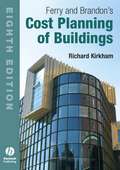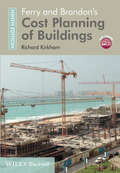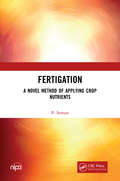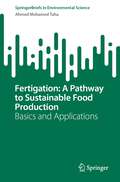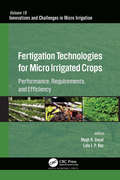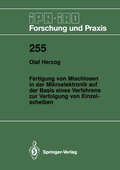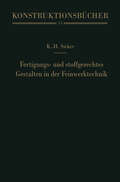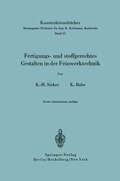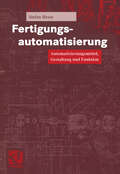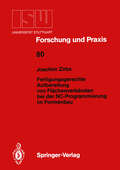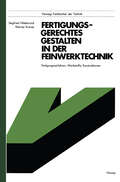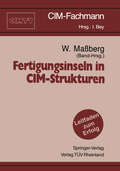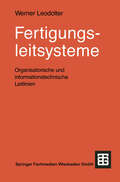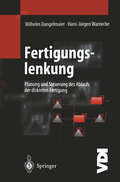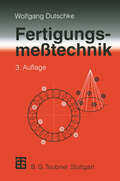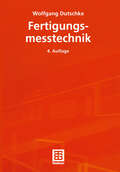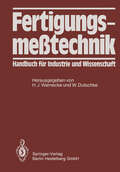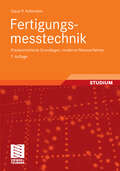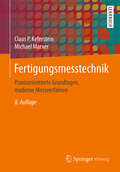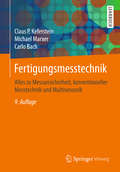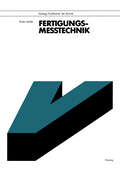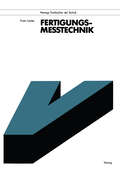- Table View
- List View
Ferry and Brandon's Cost Planning of Buildings
by Richard KirkhamFerry and Brandon’s Cost Planning of Buildings provides a comprehensive introduction to the practice and procedures of cost planning in the procurement of buildings. The eighth edition of this leading textbook has been thoroughly updated to reflect the significant changes that have occurred in the UK construction industry since the new millennium. Whilst retaining its core structure of the three-phase cost planning process originally developed by Ferry and Brandon, the text provides a thorough grounding in contemporary issues including procurement innovation, whole life-cycle costing and modelling techniques. Designed to support the core cost planning studies covered by students reading for degrees in quantity surveying and construction management, it provides a platform for understanding the fundamental importance of effective cost planning practice. The principals of elemental cost planning are covered from both pre- and post- contract perspectives; the role of effective briefing and client/stakeholder engagement as best practice is also reinforced in this text. In his revisions, Richard Kirkham reflects the many changes in the construction industry in the past eight years: procurement is given prominence early in the book; the changing role of the quantity surveyor and building economist is discussed, as is the crucial role they assume throughout the project life cycle. He emphasises the importance of early and collaborative working in the design team, as well as the impact of whole life-cycle costing.
Ferry and Brandon's Cost Planning of Buildings
by Richard KirkhamThis new edition of the classic quantity surveying textbook retains its basic structure but has been thoroughly updated to reflect recent changes in the industry, especially in procurement. Although over the last 20 years a number of new procurement methods have evolved and become adopted, the recession has seen many clients revert to established traditional methods of procurement so the fundamentals of cost planning still apply - and should not be ignored. The first edition of this leading textbook was published in 1964 and it continues to provide a comprehensive introduction to the practice and procedures of cost planning in the procurement of buildings. This 9th edition has been thoroughly updated to reflect changes that have occurred in the UK construction industry in the past six years. Whilst retaining its core structure of the three-phase cost planning process originally developed by Ferry and Brandon, the text provides a thorough grounding in contemporary issues including procurement innovation, whole life cycle costing and modelling techniques. Designed to support the core cost planning studies covered by students reading for degrees in quantity surveying and construction management, it provides a platform for understanding the fundamental importance of effective cost planning practice. The principals of elemental cost planning are covered from both pre- and post- contract perspectives; the role of effective briefing and client/stakeholder engagement as best practice is also reinforced in this text. This new edition: Addresses The Soft Landings Framework (a new govt. initiative, especially for schools) to make buildings perform radically better and much more sustainably. Puts focus on actual performance in use at brief stage, during design and construction, and especially before and after handover. Covers recent changes in procurement, especially under the NEC and PFI Provides more on PPP and long-term maintenance issues Offers an improved companion website with tutorial worksheets for lecturers and Interactive spreadsheets for students, e.g. development appraisal models; lifecycle costing models
Ferry and Brandon's Cost Planning of Buildings
by Richard KirkhamThis new edition of the classic quantity surveying textbook retains its basic structure but has been thoroughly updated to reflect recent changes in the industry, especially in procurement. Although over the last 20 years a number of new procurement methods have evolved and become adopted, the recession has seen many clients revert to established traditional methods of procurement so the fundamentals of cost planning still apply - and should not be ignored. The first edition of this leading textbook was published in 1964 and it continues to provide a comprehensive introduction to the practice and procedures of cost planning in the procurement of buildings. This 9th edition has been thoroughly updated to reflect changes that have occurred in the UK construction industry in the past six years. Whilst retaining its core structure of the three-phase cost planning process originally developed by Ferry and Brandon, the text provides a thorough grounding in contemporary issues including procurement innovation, whole life cycle costing and modelling techniques. Designed to support the core cost planning studies covered by students reading for degrees in quantity surveying and construction management, it provides a platform for understanding the fundamental importance of effective cost planning practice. The principals of elemental cost planning are covered from both pre- and post- contract perspectives; the role of effective briefing and client/stakeholder engagement as best practice is also reinforced in this text. This new edition: Addresses The Soft Landings Framework (a new govt. initiative, especially for schools) to make buildings perform radically better and much more sustainably. Puts focus on actual performance in use at brief stage, during design and construction, and especially before and after handover. Covers recent changes in procurement, especially under the NEC and PFI Provides more on PPP and long-term maintenance issues Offers an improved companion website with tutorial worksheets for lecturers and Interactive spreadsheets for students, e.g. development appraisal models; lifecycle costing models
Fertigation: A Novel Method of Applying Crop Nutrients
by P. SomanFertigation requires a thorough understanding of the science behind the technology to make it deliver the immense possibility it offers in crop production. Though the idea of fertigation existed from the times of solution culture, it did not receive the necessary attention from among plant nutritionists and agronomists when it reappeared in the context of micro irrigation. Fertilizer application in field agriculture has also not developed as a precision technology. Recommendations of the quantum of fertilizers required for a crop, at least in India are not based on current varieties of the crops, nor have they anything to do with the growth rate and developmental changes occurring while a crop is managed by the grower. Most of the fertilizer recommendations are itself very old and efforts to make them relevant to the current growing conditions, soil status, crop variety and crops reaction to the environment etc. are very limited. It is even worse when growers follow traders’ recommendations whose idea is to sell more the fertilizer they supply. Not only lower yields and very low fertilizer use efficiencies, but the deterioration of soil and water bodies are the results.Note: T&F does not sell or distribute the hardback in India, Pakistan, Nepal, Bhutan, Bangladesh and Sri Lanka. This title is co-published with NIPA.
Fertigation: A Novel Method of Applying Crop Nutrients
by P. SomanFertigation requires a thorough understanding of the science behind the technology to make it deliver the immense possibility it offers in crop production. Though the idea of fertigation existed from the times of solution culture, it did not receive the necessary attention from among plant nutritionists and agronomists when it reappeared in the context of micro irrigation. Fertilizer application in field agriculture has also not developed as a precision technology. Recommendations of the quantum of fertilizers required for a crop, at least in India are not based on current varieties of the crops, nor have they anything to do with the growth rate and developmental changes occurring while a crop is managed by the grower. Most of the fertilizer recommendations are itself very old and efforts to make them relevant to the current growing conditions, soil status, crop variety and crops reaction to the environment etc. are very limited. It is even worse when growers follow traders’ recommendations whose idea is to sell more the fertilizer they supply. Not only lower yields and very low fertilizer use efficiencies, but the deterioration of soil and water bodies are the results.Note: T&F does not sell or distribute the hardback in India, Pakistan, Nepal, Bhutan, Bangladesh and Sri Lanka. This title is co-published with NIPA.
Fertigation: Basics and Applications (SpringerBriefs in Environmental Science)
by Ahmed Mohamed TahaThis book introduces basic and practical information on fertigation to researchers, extension agents and growers. To provide understanding of the basic issues regarding the appropriate selection of fertilizer injectors, fertilizer compounds used in fertigation for growing various field and horticultural crops. The book provides useful basic principles and practical information concerning fertilizer management and fertigation techniques of field, horticulture, and medicinal and aromatic crops. The book focuses on the agronomic value of fertigation practice and provides the reader with best practical advice required for successful fertigation based on the field experience. This book summarizes the basic principles and practices of fertigation techniques to ensure accurate and efficient crop nutrition. The book consists of 5 chapters covering the following topics: Introduction to chemigation and fertigation, selecting an injector for fertilizer/chemical injection, fertilizers for fertigation, major, secondary, and micronutrient fertilizers used in fertigation, and fertigation practices: Egyptian case study. It also includes appendixes for fertigation calculation examples, calibration of an injection pump, calculating the quantities of fertilizers needed for fertigation, nutrients requirements per each ton of crop yield produced, macronutrient requirements for some filed, fiber, fruit, vegetable crops, and medicinal and aromatic plants.Fertigation is one of the smart practices that help attains sustainable food production and minimize environmental pollution. Fertigation is the application of dissolved mineral fertilizers, soil amendments, and other water-soluble products to the roots of crops through irrigation water. This book provides understanding of the basic issues regarding the appropriate selection of injectors and fertilizer compounds used in fertigation for growing various field and horticultural crops which are essential to attain higher productivity, increasing food security and reducing food contaminations. It also clarifies the advantages of fertigation and set solutions to overcome its disadvantages.
Fertigation Technologies for Micro Irrigated Crops: Performance, Requirements, and Efficiency (Innovations and Challenges in Micro Irrigation)
by Megh R. Goyal Lala I. P. RayThis new volume addresses the global water crisis by presenting new ways to use irrigation water judiciously through innovative fertigation management. It looks at the research and review work done throughout the world on micro irrigation and the techno-economic feasibility of various fertigation irrigation water management systems. Taking a multidisciplinary perspective, the chapters look at using fertigation to increase the effectiveness of irrigation systems crop performance evaluation of various crops under fertigation and irrigation methods estimating levels of crop requirements scheduling of fertigation and irrigation new fertigation equipment and technology cost components of the various irrigation and fertigation systems
Fertigation Technologies for Micro Irrigated Crops: Performance, Requirements, and Efficiency (Innovations and Challenges in Micro Irrigation)
by Megh R. Goyal; Lala I. P. RayThis new volume addresses the global water crisis by presenting new ways to use irrigation water judiciously through innovative fertigation management. It looks at the research and review work done throughout the world on micro irrigation and the techno-economic feasibility of various fertigation irrigation water management systems. Taking a multidisciplinary perspective, the chapters look at using fertigation to increase the effectiveness of irrigation systems crop performance evaluation of various crops under fertigation and irrigation methods estimating levels of crop requirements scheduling of fertigation and irrigation new fertigation equipment and technology cost components of the various irrigation and fertigation systems
Fertigung von Mischlosen in der Mikroelektronik auf der Basis eines Verfahrens zur Verfolgung von Einzelscheiben (IPA-IAO - Forschung und Praxis #255)
by Olaf HerzogFertigungs- und stoffgerechtes Gestalten in der Feinwerktechnik (Konstruktionsbücher #13)
by Karl-Heinz SiekerFertigungs- und stoffgerechtes Gestalten in der Feinwerktechnik (Konstruktionsbücher #13)
by Karl-Heinz Sieker Kurt RabeFertigungsautomatisierung: Automatisierungsmittel, Gestaltung und Funktion
by Stefan HesseDas Buch bietet anwendungsorientiert das technische Grundwissen für die Automatisierung von Arbeitsmaschinen und konzentriert sich auf den Material- und Informationsfluss. Es behandelt mechanische, fluidische und numerische Steuerungen, wie Werkstücke gefördert, zugeführt und gespannt werden, welche Aufgaben dabei Sensoren erledigen und wie man Maschinen verkettet. Dazu gehören auch die Greiftechnik und das Werkzeugmanagement. Anwendungsbeispiele schließen die Kapitel jeweils ab. Ein ausführliches Literaturverzeichnis weist Wege für eine Vertiefung des Wissens.
Fertigungsgerechte Aufbereitung von Flächenverbänden bei der NC-Programmierung im Formenbau (ISW Forschung und Praxis #80)
by Joachim ZirbsFertigungsgerechtes Gestalten in der Feinwerktechnik: Fertigungsverfahren, Werkstoffe, Konstruktionen
by Hildebrand SiegfriedFertigungslenkung: Planung und Steuerung des Ablaufs der diskreten Fertigung (VDI-Buch)
by Wilhelm Dangelmaier Hans-Jürgen WarneckeDas Buch versucht, unterschiedliche Methoden der Fertigungslenkung auf eine gemeinsame Basis zu stellen und damit eine einheitliche Sicht auf den Fertigungsprozeß zu geben. Dabei werden die Methoden, die heute in PPS, Fertigungssteuerung und Ablaufplanung verwendet werden, auf ihre Gemeinsamkeiten hin untersucht, einheitliche Strukturen aufgezeigt und die Grundlage für ein Theoriegebäude gebildet. Auf dieser Basis werden die heute verwendeten Methoden systematisch dargestellt. Für den Leser von besonderem Nutzen sind Fallstudien und das Aufzeigen von Feldern und Ansätzen, die von heute eingesetzten Systemen nicht abgedeckt werden.
Fertigungsmeßtechnik
by Wolfgang DutschkeDas Buch gibt einen Überblick über die Fertigungsmesstechnik von Handmessmitteln bis zur Koordinatenmesstechnik und von Messvorrichtungen bis zur Sichtprüfung und deren Automatisierung. Es werden Begriffe und Verfahren wie z. B. die Messunsicherheit und die statistische Prozessregelung genau so beschrieben wie modernere Messverfahren wie z. B. die berührungslose Lasermesstechnik und Bildverarbeitung. Das Buch wurde für die praxisorientierte Ausbildung und den Praktiker im Betrieb konzipiert.
Fertigungsmesstechnik
by Wolfgang DutschkeDas Buch gibt einen Überblick über die Fertigungsmesstechnik von Handmessmitteln bis zur Koordinatenmesstechnik und von Messvorrichtungen bis zur Sichtprüfung und deren Automatisierung. Es werden Begriffe und Verfahren wie z. B. die Messunsicherheit und die statistische Prozessregelung genau so beschrieben wie modernere Messverfahren, die berührungslose Lasermesstechnik und Bildverarbeitung. Anschaulich vermittelt dieses Lehrbuch die Grundlagen der Messtechnik, wie sie in Industrie und Technik Anwendung finden und bei der ingenieurwissenschaftlichen Ausbildung wie auch in der Praxis immer wieder benötigt werden. Verweise auf weiterführende Literatur finden sich nach jedem Kapitel und ermöglichen vertieftes Arbeiten zu jedem Themenpunkt. Die 4. Auflage wurde dem Stand der Normung entsprechend aktualisiert und mit Blick auf technische Entwicklungen der letzten Zeit überarbeitet.
Fertigungsmesstechnik: Praxisorientierte Grundlagen, moderne Messverfahren
by Claus P. KefersteinDieses Lehrbuch führt in Entwicklung, Bedeutung und Zusammenhänge der Mess- und Prüfverfahren für industriell hergestellte Produkte ein. Die Schwerpunkte liegen auf den Verfahren für Messraum und Betrieb, auf den fertigungs- und prozessorientierten Verfahren sowie auf den berührungslosen, optischen Verfahren. Vermittelt werden die Grundlagen der Messtechnik, wie sie in Industrie und Technik Anwendung finden und bei der ingenieurwissenschaftlichen Ausbildung wie auch in der Praxis immer wieder benötigt werden. In der aktuellen Auflage wurde ein Kapitel zur Mikromesstechnik sowie ein deutsch-englisches und englisch-deutsches Sachwortverzeichnis aufgenommen.
Fertigungsmesstechnik: Praxisorientierte Grundlagen, moderne Messverfahren
by Claus P. Keferstein Michael MarxerDie Vorzüge: Von den Handmessmitteln bis zur Mikromesstechnik, die optische Mess- und Rauheitsmesstechnik sowie relevante Teile des QM werden mit aussagekräftigen Bildern praxisnah dargestellt – ein ausführliches Normenverzeichnis lässt schnell gültige Standards finden – Links zu allen wichtigen Metrologie-, Normen- und Akkreditierungsinstitutionen – ein ausführliches zweisprachiges Sachwortverzeichnis ermöglicht ein schnelles Auffinden der gesuchten Begriffe sowie die Korrespondenz mit englischsprachigen Kollegen – besonders gut für eine praxisgerechte Ausbildung an Hochschulen und Weiterbildungsinstitutionen geeignet – für jeden Fertigungsbetrieb, in Konstruktion und Entwicklung sowie im Messraum und Qualitätsmanagement ein zuverlässiges Nachschlagewerk und effizienter Ratgeber.
Fertigungsmesstechnik: Alles zu Messunsicherheit, konventioneller Messtechnik und Multisensorik
by Claus P. Keferstein Michael Marxer Carlo BachDie Vorzüge dieses Lehrbuches: Von den Handmessmitteln bis zur Mikromesstechnik, die optische Mess- und Rauheitsmesstechnik sowie relevante Teile des QM werden mit aussagekräftigen Bildern praxisnah dargestellt – ein ausführliches Normenverzeichnis lässt schnell gültige Standards finden – Links zu allen wichtigen Metrologie-, Normen- und Akkreditierungsinstitutionen – ein ausführliches zweisprachiges Sachwortverzeichnis ermöglicht ein schnelles Auffinden der gesuchten Begriffe sowie die Korrespondenz mit englischsprachigen Kollegen – besonders gut für eine praxisgerechte Ausbildung an Hochschulen und Weiterbildungsinstitutionen geeignet – für jeden Fertigungsbetrieb, in Konstruktion und Entwicklung sowie im Messraum und Qualitätsmanagement ein zuverlässiges Nachschlagewerk und effizienter Ratgeber. Die vorliegende Auflage wurde überarbeitet und um die Kapitel Messunsicherheit bei KMGs, Werkzeugmaschinenüberwachung und Foucault-Laser erweitert.
Fertigungsmeßtechnik (Viewegs Fachbücher der Technik)
by Erwin LemkeDas weite Gebiet der Fertigungsmeßtechnik vermittelt der Autor gleichermaßen an Studierende wie an Praktiker. Das Buch hat die Meßgeräte und Meßverfahren der Fertigungstechnik zum Inhalt. Es ist zugleich als Lehr- wie auch als Nachschlagewerk angelegt. Neben der Einführung in alle Bereiche der Fertigungsmeßtechnik und zahlreichen Beispielen gibt eine Fülle von Zeichnungen, Tafeln und Tabellen einen Überblick über den aktuellen Stand der Meßnormen.
